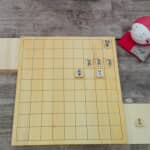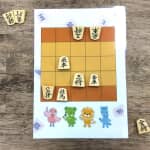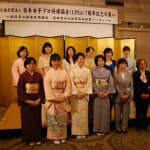Shogi 10 November 2018
Shogi Rules – How to Play Shogi – : Step 3-7 Giving Check with a Piece Not to Be Captured for Free
A professional Shogi player invites you to the world of Shogi along with traditional Japanese culture. In this series, there are three steps and each step has around 10 lessons. Even though you don’t know about Shogi, through these three steps you will get knowledge to enjoy it.
*Please note that the Kanji numbers in pictures are spelled in English in the text.
The following Shogi boards have a face with files (vertical rows) numbered 1 through 9, from right to left, and ranks (horizontal rows) designated with Kanji characters, “一” (One) to “九” (Nine), from top to bottom. On the other hand, in the text, each Kanji character is replaced with an alphabet, from “a” to “i” : “一” with “a”, “二” with “b”, … and “九” with ”i”.
Step 3-7: Giving Check with a Piece Not to Be Captured for Free
Today’s goal is to learn the way to check your opponent’s Gyoku (King), preventing the piece that is giving check from being captured for free. Now you are successfully giving Check, but if the piece will be captured soon, your attack will turn out to be wasteful and lead you in an unfavourable situation.
Let’s give Check with a piece placed on a board or a piece stand. In doing so, you should make sure that the piece won’t be captured for free.
1. Where to Drop
You have Hisha (Rook) as your hand piece and are going to use it to check. Which is the best square you drop the piece on?
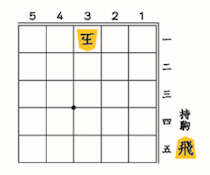
Picture #1: Let’s Check
The answer is to drop Hisha (Rook) as R*3d. Your dropped piece won’t be captured on the next move. Look at the below picture, other than this, any square with a circle is available.
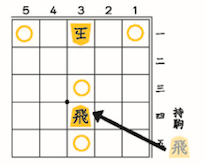
Picture #2: Check from a Square Apart from the Targeted Piece
Now, what if you check from an adjacent square, R*3b? The opponent’s Gyoku (King) will capture your Hisha (Rook). You should take into consideration reaching power of each piece.
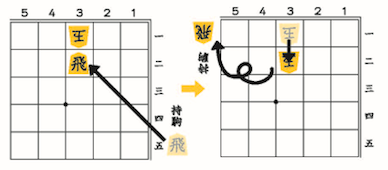
Picture #3: Failure Case
2. The Way to Check from an Adjacent Square without Being Captured
You have Kin (Gold) as a hand piece. In the below situation, which square you should drop Kin (Gold) to?
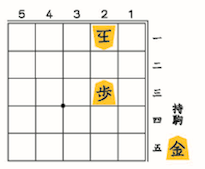
Picture #4: Where to Drop Kin (Gold)?
What if you drop Kin (Gold) to the square of 2b, as G*2b? Even though Gyoku (King) captures dropped Kin (Gold), Fu (Pawn) will take Gyoku (King) back.
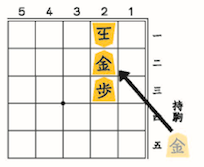
Picture #5: Check from an Adjacent Square
When you check from an adjacent square, you need to have another backup piece protecting the attacking piece. When you deliver checkmate, generally, you need at least two pieces working together. Consider how reaching power of your pieces affects each other.
3. Check with a Piece, Preventing the Piece from Being Captured
It’s time to have a real game like situation. When you give Check in a real game, there must be a lot of pieces, including yours and your opponent’s. Try to check with a piece, while preventing the piece from being captured for free and not getting confused by other pieces.
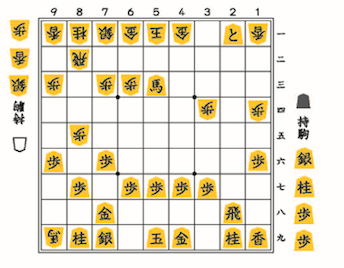
Picture #6: Check without Being Captured for Free
The best move here is to drop Kei (Knight) on the square of 4c, N*4c. You may drop Gin (Silver) to the square of 4b, S*4b, but the dropped piece will be captured by the opponent’s Kin (Gold) or Hisha (Rook). It’s not the case in which your piece won’t be captured.
4. Advanced Practice
Drop a piece to the square that looks apparently not to be safe for you.
Next practice is a bit challenging. You are going to drop your hand piece on the square covered by reaching power of your opponent’s piece. At a glance, you may think your dropped piece will be captured soon. Is that so? Let’s have a look at what will happen.
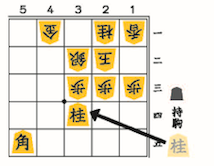
Picture #7: Check with Your Hand Piece, Kei (Knight)
Drop your hand piece, Kei (Knight), as N*3d. At first, you may think your dropped piece will be captured by Fu (Pawn). If this happens, you, now, can capture Gyoku (King) with your Kaku (Bishop). That means your dropped Kei (Knight) won’t be captured.
There is another typical situation of giving Check named Ikkenryu, in which a promoted Kaku (Bishop), Ryu, is located one square laterally or vertically away from the opponent’s Gyoku (King). I think this is well formulated technique. Look at the below;
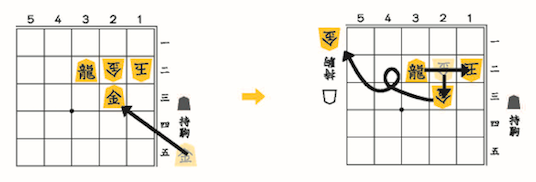
Picture #8: Ikkenryu
Drop Kin (Gold) to the square of 2c, G*2c. Once the dropped Kin (Gold) is captured, your Ryu, ,Promoted Rook, will be ready to capture the opponent’s Gyoku (King). This is very common situation and you may often have this in a real game. Remember to take advantage of this situation.
After Today’s Lesson
The explanation about Ikkenryu appealed to my girls’ emotions. They said, “The name, Ikkenryu , sounds great and it looks like a decoy strategy!” As they said, this is, indeed, well formulated technique in which one less strong piece disguises as an attacker, but there is strongRyu (Promoted Rook) as a real attacker. “The more you can find Check situations, the better you attack Gyoku (King)”, said Akiko-sensei. I do hope that my children can get the hang of giving Check, avoiding the attacking piece to be captured for free.
The essence of “Giving Check with a Piece Not to Be Captured for Free” is provided in our “Shogi Lesson Book for Beginners Vol. 2”.
